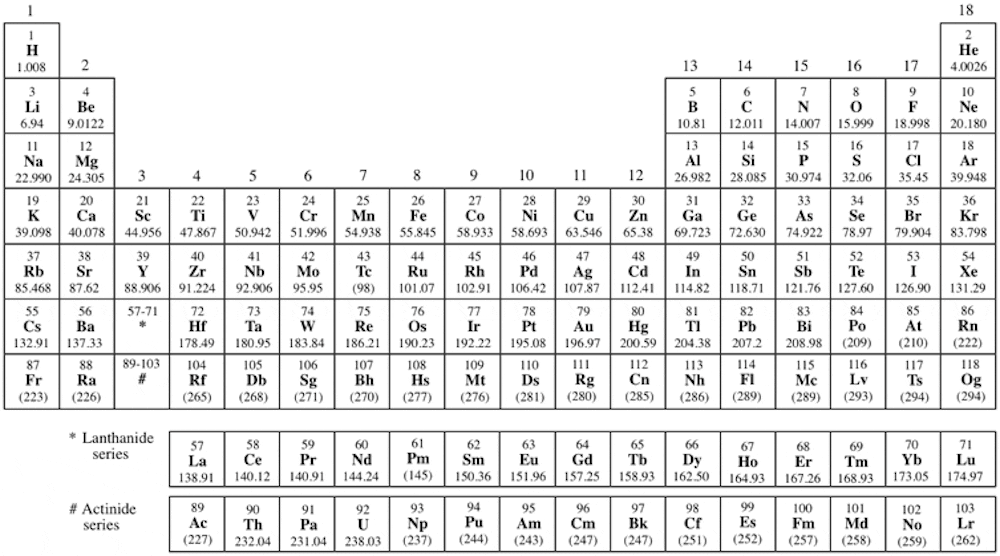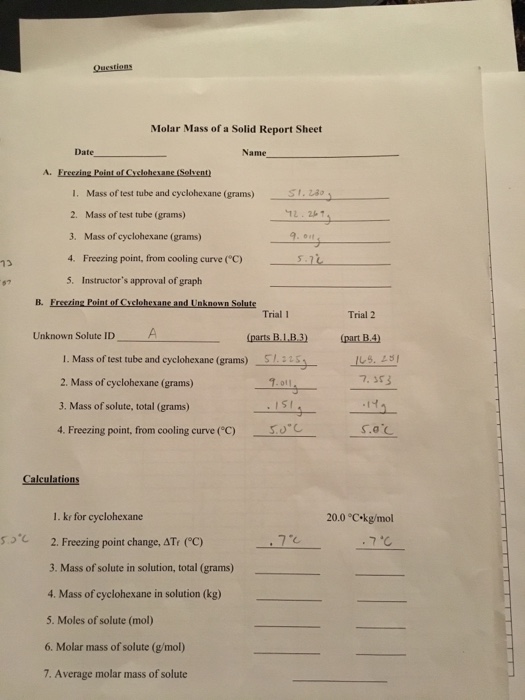| 1 | 2 | 3 | 4 | 5 | 6 | 7 | 8 | 9 | 10 | 11 | 12 | 13 | 14 | 15 | 16 | 17 | 18 |
| 1 H Hydrogen 1.008 | Select elements and see the molar mass of the compound Chemical formula (Hill notation)Molar mass (g/mol) | 2 He Helium 4.002602 | |||||||||||||||
| 3 Li Lithium 6.94 | 4 Be Beryllium 9.0121831 | 5 B Boron 10.81 | 6 C Carbon 12.011 | 7 N Nitrogen 14.007 | 8 O Oxygen 15.999 | 9 F Fluorine 18.998403163 | 10 Ne Neon 20.1797 | ||||||||||
| 11 Na Sodium 22.98976928 | 12 Mg Magnesium 24.305 | 13 Al Aluminium 26.9815385 | 14 Si Silicon 28.085 | 15 P Phosphorus 30.973761998 | 16 S Sulfur 32.06 | 17 Cl Chlorine 35.45 | 18 Ar Argon 39.948 | ||||||||||
| 19 K Potassium 39.0983 | 20 Ca Calcium 40.078 | 21 Sc Scandium 44.955908 | 22 Ti Titanium 47.867 | 23 V Vanadium 50.9415 | 24 Cr Chromium 51.9961 | 25 Mn Manganese 54.938044 | 26 Fe Iron 55.845 | 27 Co Cobalt 58.933194 | 28 Ni Nickel 58.6934 | 29 Cu Copper 63.546 | 30 Zn Zinc 65.38 | 31 Ga Gallium 69.723 | 32 Ge Germanium 72.630 | 33 As Arsenic 74.921595 | 34 Se Selenium 78.971 | 35 Br Bromine 79.904 | 36 Kr Krypton 83.798 |
| 37 Rb Rubidium 85.4678 | 38 Sr Strontium 87.62 | 39 Y Yttrium 88.90584 | 40 Zr Zirconium 91.224 | 41 Nb Niobium 92.90637 | 42 Mo Molybdenum 95.95 | 43 Tc Technetium [97] | 44 Ru Ruthenium 101.07 | 45 Rh Rhodium 102.90550 | 46 Pd Palladium 106.42 | 47 Ag Silver 107.8682 | 48 Cd Cadmium 112.414 | 49 In Indium 114.818 | 50 Sn Tin 118.710 | 51 Sb Antimony 121.760 | 52 Te Tellurium 127.60 | 53 I Iodine 126.90447 | 54 Xe Xenon 131.293 |
| 55 Cs Caesium 132.90545196 | 56 Ba Barium 137.327 | 57 La Lanthanum 138.90547 | 72 Hf Hafnium 178.49 | 73 Ta Tantalum 180.94788 | 74 W Tungsten 183.84 | 75 Re Rhenium 186.207 | 76 Os Osmium 190.23 | 77 Ir Iridium 192.217 | 78 Pt Platinum 195.084 | 79 Au Gold 196.966569 | 80 Hg Mercury 200.592 | 81 Tl Thallium 204.38 | 82 Pb Lead 207.2 | 83 Bi Bismuth 208.98040 | 84 Po Polonium [209] | 85 At Astatine [210] | 86 Rn Radon [222] |
| 87 Fr Francium [223] | 88 Ra Radium [226] | 89 Ac Actinium [227] | 104 Rf Rutherfordium [267] | 105 Db Dubnium [270] | 106 Sg Seaborgium [271] | 107 Bh Bohrium [270] | 108 Hs Hassium [277] | 109 Mt Meitnerium [276] | 110 Ds Darmstadtium [281] | 111 Rg Roentgenium [282] | 112 Cn Copernicium [285] | 113 Nh Nihonium [285] | 114 Fl Flerovium [289] | 115 Mc Moscovium [289] | 116 Lv Livermorium [293] | 117 Ts Tennessine [294] | 118 Og Oganesson [294] |
| 58 Ce Cerium 140.116 | 59 Pr Praseodymium 140.90766 | 60 Nd Neodymium 144.242 | 61 Pm Promethium [145] | 62 Sm Samarium 150.36 | 63 Eu Europium 151.964 | 64 Gd Gadolinium 157.25 | 65 Tb Terbium 158.92535 | 66 Dy Dysprosium 162.500 | 67 Ho Holmium 164.93033 | 68 Er Erbium 167.259 | 69 Tm Thulium 168.93422 | 70 Yb Ytterbium 173.054 | 71 Lu Lutetium 174.9668 | ||||
| 90 Th Thorium 232.0377 | 91 Pa Protactinium 231.03588 | 92 U Uranium 238.02891 | 93 Np Neptunium [237] | 94 Pu Plutonium [244] | 95 Am Americium [243] | 96 Cm Curium [247] | 97 Bk Berkelium [247] | 98 Cf Californium [251] | 99 Es Einsteinium [252] | 100 Fm Fermium [257] | 101 Md Mendelevium [258] | 102 No Nobelium [259] | 103 Lr Lawrencium [262] | ||||
List Of Molar Masses

Molar Mass Of Argon In G


- It will calculate the total mass along with the elemental composition and mass of each element in the compound. Use uppercase for the first character in the element and lowercase for the second character. Examples: Fe, Au, Co, Br, C, O, N, F. You can use parenthesis or brackets. Finding Molar Mass. Read our article on how to calculate molar.
- Definitions of molecular mass, molecular weight, molar mass and molar weight. Molecular mass (molecular weight) is the mass of one molecule of a substance and is expressed in the unified atomic mass units (u). (1 u is equal to 1/12 the mass of one atom of carbon-12) Molar mass (molar weight) is the mass of one mole of a substance and is.
Since in the normal production process, argon was used as a protecting gas, the possibility of suffocation in an argon atmosphere was investigated. This was rendered more difficult because of the natural content of 0.93 vol.% argon in air and since the excessive argon could have been removed by the resuscitation attempts. Molar mass, symbol M,is the mass of one mole of a substance (chemical element or chemical compound).It is a physical property which is characteristic of each pure substance. The base SI unit for mass is the kilogram but, for both practical and historical reasons, molar masses are almost always quoted in grams per mole (g/mol or g mol–1.
